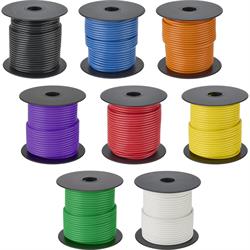Wiring and Battery Cable Routing - 1967 Chevelle
With relocating the battery to the trunk of a vehicle, come several other subsequent projects. Not least of which being getting the power back up to the front of the vehicle where it belongs. For this task I chose the Speedway “welding cable” 2 gauge battery cable. This particular cabling is well suited to a longer reach. By definition, electrical current is the flow of electrons along a conductor. What most people don’t know is that electrons travel on the outside of the conductor (wire). The difference between welding cable and normal battery cable is the thickness of the wire strands. Welding cable consists of very fine strands. This allows the wire to more easily handle the demand and serves as a better conductor. Especially when travelling a longer distance.
In my build I am also routing some power and fuel pump wires to accommodate the EFI system being installed. Since these wire will follow a similar path and terminate in similar locations I’ve elected to route them all together.
Part of the preparation is untangling and stretching out all the wire and cable that we’ll be using. I found that taping them to the track of the garage door made a sturdy place that kept them (mostly) off the floor while I prepared them for installation.
All these wires will live on the passenger’s side of the car. Laying them out in the approximate area helps make routing decisions happen more quickly as opposed to working off of a bulk roll of material.
The best part of having the entire Speedway Motors catalog at your fingertips are the great time savers like the line clamps I used to hold these wires to the frame rail. While they were made to hold fluid lines the larger size also accommodates larger wires like these. For the attachment to the frame, I positioned them where I wanted and made a mark inside the rail using a transfer punch. Then I drilled a hole and tapped it for a #10 machine screw. That made for an easy and clean installation that needed no access to the outside of the frame rail, which on these cars is very limited.
A product I had been dying to try out on a big project was the Painless Powerbraid. This is like the split loom of years past except 150% better.
PowerBraid and ClassicBraid are woven plastic sleeves that are a great alternative to wrapping wires in tape or using the hard plastic accordion style split-loom. It helps hide wires and lets the items you’d like to draw attention to, shine. I cheated a little bit by using a drill to slightly twist together the two wires that were going inside. This helped keep everything straight and together while I fed the loom over the wires.
Something else worth mentioning are these handy little magnetic fasteners by Mag Daddy. They come in a variety of configurations but the ones I’ve found most handy are the zip tie compatible ones. They make quick work of securing wires that you want out of the way but may need easy access to later. With 28 lbs of magnetic clamping force they’ll hold just about anything you want.




